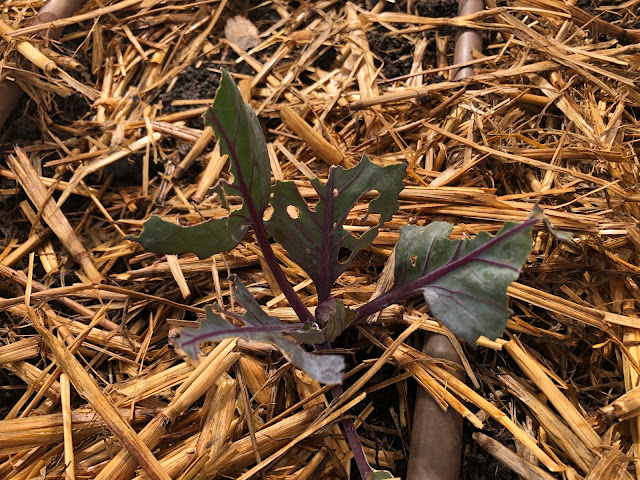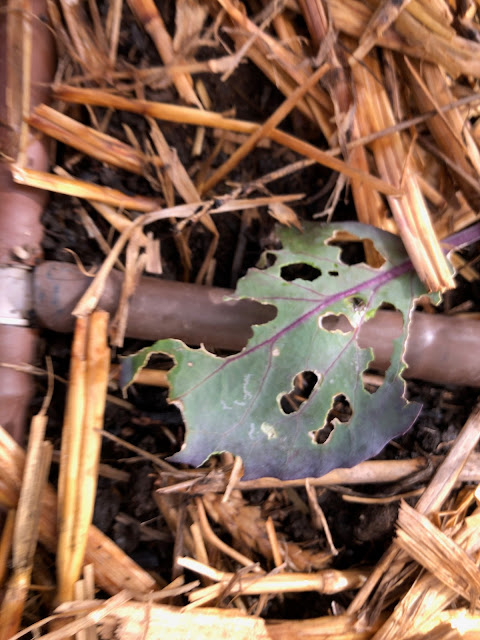
Don’t fret: It’s cooler, so things actually aren’t too bad

|
|
Most of the damage to this plant at the Fair Oaks Horticulture Center was caused by birds, says master gardener Gail Pothour. The leaves are eaten along the edges. (Photos: Kathy Morrison)
|
The oranges are splitting again. The new lettuce disappeared overnight. The carrots still aren’t sprouting. Help! Who decided that fall was an easy time to garden?
Take a deep breath. Notice the air — it’s cooler in the morning, isn’t it? Even the afternoons are better. Little spikes into the low 90s are much easier to handle than, oh, 112 degrees. Right? OK, then. Relax.
But fall does have its challenges. Here are five, and how to deal with them (or at least explain them):

|
|
Same plant as above, but a different leaf and likely different pest for most
of the damage: Caterpillars sit on the ribs and eat the leaf centers. |
Caterpillar pests crawl along the ribs of the leaves and take chunks out of the middle. At worst, they crawl down inside the heads of the developing vegetables where they can't be reached. So catch them early, if you have an outbreak. Row covers will keep the butterflies from laying eggs on the plants. Bt, short for bacillus thuringiensis, is an excellent bacteria-based caterpillar fighter.
2. Disappearing sprouts or transplants. If you see damage along the edges of the vegetable leaves, suspect birds, Pothour says. Young, fresh plants look good to them, too. Birds will sit on the soil next to the plant to feast, and can eat it down to the ground if it's young. To keep birds off the young plants, try row covers, mesh baskets or the like. Just be sure to anchor those covers so the birds can't get underneath.
3. Sprouts not appearing at all. Did you plant carrots? For such a common vegetable, they take a long time to germinate. Weeks, in fact. Be patient. Then when they do sprout and get to be about 2 inches tall, don't forget to thin them. They need space to grow. And if you're planting beets or chard, rinse the seeds first, Pothour advises. This removes a chemical on the seeds that inhibits germination. Incidentally, the master gardeners have published a great guide to growing beets .
4. Oranges splitting. This has become more of a Northern California problem in October just the past few years. It's not a disease. Basically, spikes in warm weather and lack of irrigation together signal the tree to suck some moisture out of the fruit. The fruit wall weakens. Then when the tree gets more moisture from rain or irrigation, it sends it back, bursting the weakened fruit. I wrote a full blog post on this problem last year. I've lost only two oranges to splitting so far this year, thank goodness.
5. Perennials looking ragged. Perennials tend to be leggy in late summer, and can be pruned or cut down now, especially if you see new sprouts forming at the base of the plant. Even if you don't see any, it's a good time to clean them up. Perennial herbs can use a good fall haircut, too.
Comments
0 comments have been posted.Sacramento Digs Gardening to your inbox.
Sites We Like
Garden Checklist for week of May 12
Get your gardening chores and irrigation done early in the day before temperatures rise.
* Plant, plant, plant! It’s prime planting season in the Sacramento area. Time to set out those tomato transplants along with peppers and eggplants. Pinch off any flowers on new transplants to make them concentrate on establishing roots instead of setting premature fruit.
* Direct-seed melons, cucumbers, summer squash, corn, radishes, pumpkins and annual herbs such as basil.
* Harvest cabbage, lettuce, peas and green onions. This heat will cause leafy greens and onions to flower; pick them before they bolt.
* In the flower garden, direct-seed sunflowers, cosmos, salvia, zinnias, marigolds, celosia and asters.
* Plant dahlia tubers. Other perennials to set out include verbena, coreopsis, coneflower and astilbe.
* Transplant petunias, marigolds and perennial flowers such as astilbe, columbine, coneflowers, coreopsis, dahlias, rudbeckia and verbena.
* Keep an eye out for slugs, snails, earwigs and aphids that want to dine on tender new growth.
* Feed summer bloomers with a balanced fertilizer.
* For continued bloom, cut off spent flowers on roses as well as other flowering plants.
* Got fruit trees? If you haven't already done so, thin orchard fruit such as apples, peaches, pears, pluots and plums before they grow too heavy, breaking branches or even splitting the tree. Leave the largest fruit on the branch, culling the smaller ones, and allow for 5 to 6 inches (or a hand's worth) between each fruit.
* Thin grape bunches, again leaving about 6 inches between them. For the remaining bunches, prune off the "tail" end, about the bottom third of the bunch, so that the plant's energy is concentrated in the fruit closest to the branch.
* As spring-flowering shrubs finish blooming, give them a little pruning to shape them, removing old and dead wood. Lightly trim azaleas, fuchsias and marguerites for bushier plants.
* Add mulch to the garden to help keep that precious water from evaporating. Mulch also cuts down on weeds. But don’t let it mound around the stems or trunks of trees or shrubs. Leave about a 6-inch to 1-foot circle to avoid crown rot or other problems.